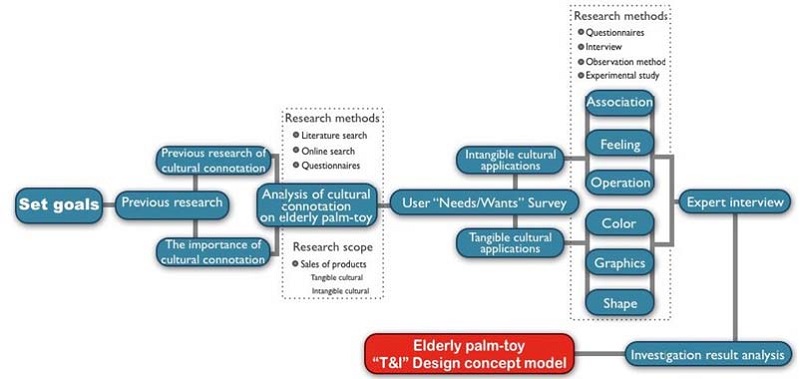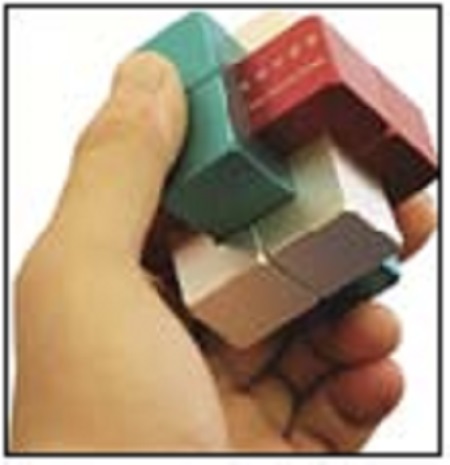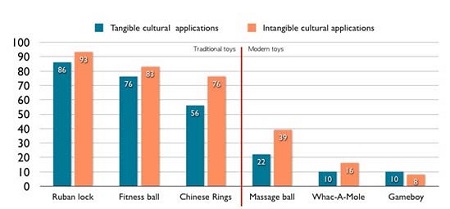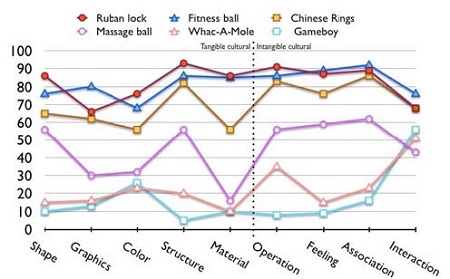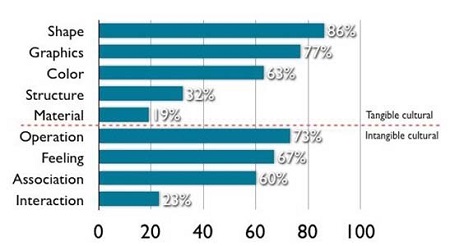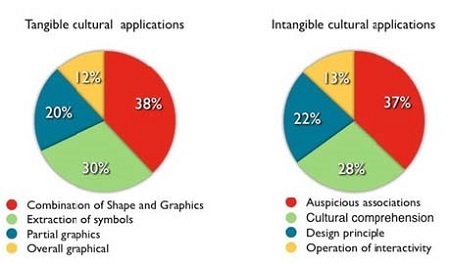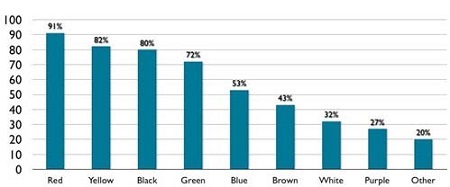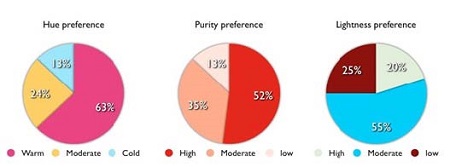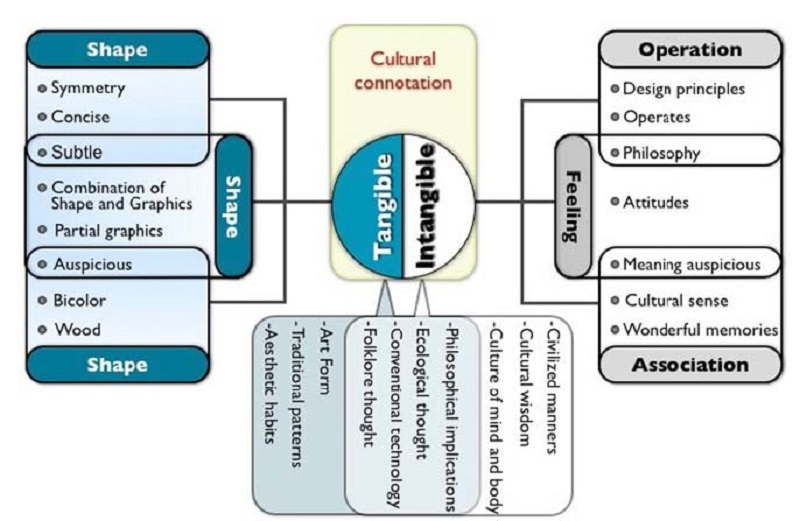
The Application Strategy of the Palm-toy Cultural Connotation for Chinese Elderly
Abstract
Background China is a country with the fastest speed of aging population and the largest scale of the elderly population. The elderly and its related problems have aroused people's concern widely, and the roll of toy for the elderly has been recognized by both enterprises and consumers. Consequently, the consumer market is growing. However, the elderly consumers have a strong sense of cultural identity from their experience, which largely determine the elderly consumers’ consumption habits and orientation. Therefore, it should be emphasized that the importance and necessity of the application of the cultural connotation in the development of the elderly products.
Methods This paper mainly focuses on the analysis of the cultural connotation of the existing products. It analyzes objectively and scientifically through the analysis of the existing products’ culture connotation, the study of the application cases on the existing products, and survey of the consumer demand, to obtain the application strategy of the culture connotation in the development of the elderly products.
Results This paper is based on the application of tangible cultural connotation and intangible cultural connotation and combines with the factors; product form, shape, color, operation, feelings, association and so on. Finally, the new Tangible & Intangible cultural connotation application strategy is developed.
Conclusions The research conclusions are as follows, as a result of the long-term impact of national and regional culture, the elderly have a strong cultural sense of belonging. It is necessary and feasible to apply the culture connotation in the design and development process of the elderly palm-toy. The significance of this study is that it provides a new strategy for the application of the cultural connotation in the design and development process of the elderly palm-toy. It also promotes the development of the Chinese elderly toy industry.
Keywords:
Elderly palm-toy, Cultural connotation, Tangible Culture, Intangible Culture, Application strategy1. Introduction
1. 1. Background and Purpose of the Research
China is one of the countries experiencing rapid increases in the number and percentage of the elderly population. At present, the elderly demographic has surpassed 200 million, account for 15% of the total population. Since the implementation of the policy of family planning in 1978, Chinese family with one child in urban areas has brought the problem; new demographic phenomenon is emerging. One couple has to support one child and four elderly dependents. On this occasion, how to help the elderly live a happier life has become a social issue even if there is conflict to solve among family. In 2012, China has formulated a plan that addressed the issue of the population aging actively and develop elderly service industry vigorously, and rise "address the issue of the population aging actively "to the height of the law. But in Chinese market, there are few products especially for the elderly people even no specialized production enterprises. The industrialization and marketization of the elderly products has not formed. Most of the elderly products are medical auxiliary products, or products to meet the basic needs of the elderly. The leisure and entertainment products like toys are very few. Most existing products can only meet the physiological needs, ignoring culture connotation and psychological care. Among the toys for elder people, the handheld toys require only hand action, and they have no other requirement for the body state. Also as to the using environment, they have no limitation of the space or the weather to use. They can be played at anytime and anywhere. So goal of this research is to study the status of the elderly palm-toy in China and make case analysis and survey analysis on consumers’ cognition towards culture connotation, thus, to provide a new strategy for the application of cultural connotation in the design and development process of the elderly palm-toy.
1. 2. Research Scope and Methods
The process of the research goes as follows.
Firstly, to propose a new strategy for cultural connotation of the elderly palm-toy, this research set up a targeted research program. Secondly, the author investigated and analyzed the status of the elderly palm-toy in China through literature search and visit. Thirdly, the author made case analysis on the representative of the toy products focused on the application of culture connotation. Fourthly, based on the above research, the author conducted a survey about 106 consumers’ needs for culture connotation through multiple means like direct interviews, questionnaire survey, in-depth interviews, observation, user experience, empirical survey. Finally, the author obtained the key points of culture connotation application through expert interviews. At last, according to the analysis on the above contents, a new model of the T&I(Tangible & Intangible) design strategy was proposed, which is based on the combination of tangible and intangible form, consist of shape, graphics, color, operation, experience and association.
2. Theoretical Research
2. 1. The Importance of Cultural Connotations in the Elderly Toys
Toys were born with the birth of a human beings. They are appliances used for playing and entertainment. For the elderly, toys can not only meet the spiritual needs, but also benefit fitness puzzle. Therefore, we can summarize the concept of elderly toys as appliances suitable for the elderly to play and entertain and designed according to the physiological and psychological characteristics of the elderly.
In China, the birth and advancements in toys is a long historical course. It reflects the development stages of economic, scientific, traditional ideology, cultural and artistic as well as the life condition of the human society in different historical stages. In the course of the development of human society, the toy is not only for people's entertainment and leisure, but also the embodiment of human life experience, and it also carries the heritage and development of culture. It is also the embodiment of people's living conditions. As other art forms, the toy also has its own special culture connotation. In different historical periods, it was not only influenced by all kinds of culture, but also promoted the development of the culture. It has both traditional culture universals and its own specific culture connotation. It is an important part of Chinese traditional culture and plays a unique role in the history of Chinese culture. However, affected by factors like industrial production, "globalization" thought, the spread of foreign culture, rapid development science and technology and so on, at present, the traditional culture of Chinese toys has become increasingly scarce. A large numbers of children’s toys are affected by "Animation culture" and high-tech products, while the products with the traditional culture connotation have become less and less. This may have little effect on children, but for the elderly with rich life experience, and strong cultural sense of the cultural connotation, the application of cultural connotation is particularly important.
2. 2. Previous Studies on Culture Connotation
In product design, the concept of applying cultural connotation is to reflect the national spirit and cultural ideas and other contents through products, which is the embodiment of consumers’ habits, aesthetic needs and lifestyles. In the field of product design, there are some research results, but there are not many objective and comprehensive research results for the elderly. In previous research, Xu Xihua's On the Cultural Essence of Product Design describes the influence factors like art, science, social psychology aesthetic idea, national tradition, ethics and so on in product design. Xu emphasizes Chinese entrepreneurs must transform the product design concept from technological design to cultural (Humanities) design. Chen Hongru (2013) proposed the use of traditional patterns must be combined with product design and function, as well as suggestions on the application of patterns in the overall, local, meaning and other aspects of the combination with product elements in Research on Chinese Traditional Patterns in Product Design Application. Rung-Tai Lin(2007)“Transforming Taiwan Aboriginal Cultural Features into Modern Product Design: A Case Study of a Cross-cultural Product Design Model”. Taking a cup named "Linnak" as an example, it expounds the application of cultural characteristics in product design, and proposes a model of culture design as three phase (identification, conversion, implementation). Chen Hongru & Bum-Kyu Kang & Qian Hao (2014) put forward the design concept ; integrates the special requirements and the specific culture connotation in the elderly products in the Research on Culture connotation Charles Kostelnick“cultural Adaptation an Information design: Two Contrasting Views” put forward that it is difficult to construct a universal visual language in the world, and it is proved that there are individual differences in aesthetic prefences of consumers in the specific space and time. Jane Park & Park Young-soon proposed three application methods of patterning the Hangeul with auspicious meaning in the paper“How to apply Hangul characters for representing meanings in the Korean cultural goods”. The new method of applying Hangeul in the cultural products is achieved by the way of changing the pattern of the auspicious words. In the paper” An Analysis of the Traditional Play-Related Cultural Products in Korea, China, and Japan” , Lee Mi-suk & Sa Jin-kang & Chung Kyung-hee put forward “it is necessary to develop distinct and various products which meet consumers` needs and various design motifs which involve the characteristics of Korean Masque and create a diverse price zone by implementing a cost segmentation strategy in developing Korean Masque- related cultural products.” through the investigation and analysis on the Chinese Japanese and Korean drama products. In addition, the torch and the medal design of the 2008 Beijing Olympic Games is also a very good embodiment of the cultural connotation in the product design application. However, in previous research results, the application of cultural elements is mostly in the form of the product, no cultural ideas.
3. Analysis on the Culture Connotation of the Elderly Palm-Toy
3. 1. The Application Status of Cultural Elements in Elderly Toys
At present, Chinese palm-toy market is still not established, the elderly toys on the market are mostly traditional fitness toys and educational toys. Fitness and educational toys operated mainly by hand take a large proportion. Table 1 displays 6 representative elderly palm-toy culture connotations obtained by summarizing data from China's "Taobao", "Jingdong" "Amazon".
(table2) The author invited 18 professors, 21 designers and 21 elderly consumers to evaluate the culture connotation of 6 above-mentioned toys. The evaluation elements are mainly divided into two aspects, "tangible" (material) and "intangible" (ideaistic). "Tangible" evaluation aspects are form, color design, structure, material and other factors. "Intangible" aspects of are usage method, operation process, psychological feelings, culture association and other factors. Table 3 is the evaluation result of the application of culture elements. A higher score represents a higher level of cultural connotation.
From the evaluation results, we can see that the traditional elderly palm-toy reflect the application of culture connotation in some aspects. But the modern elderly palm-toy has little culture connotation, most emphasize on scientific level and use function. With the continuous improvement of people's living standards, the elderly people’s demand for palm-toy will also produce a corresponding change. The improvement of the traditional elderly palm-toy and the development of new products are imperative. However, the existing new products in the market do not consider culture connotation that can meet the elderly people’s psychological and cultural needs. As a result, the cultural needs and cultural sense of belonging of the elderly has not been met.
3. 2. A Case Study on the Application of Culture Connotation
On October 11, 2014, Chinese Premier Li Keqiang presented a Ruban Lock made of aluminum alloy to the German Chancellor Angela Merkel during his visit to Germany. The reason for "Ruban lock" becoming the national present are not only its use of sophisticated materials and German technology, but also represents the perfect combination of Chinese manufacturing and German manufacturing, along with Chinese traditional culture and wisdom.
Figure 2 is "National present Ruban lock". Figure 3 is traditional Ruban lock.
First of all, the form of Ruban Lock is usually a symmetrical structure composed of six pieces of wood. In traditional Chinese architecture and implements, the symmetry shape is very common, such as the Imperial Palace, the courtyard, the four sheep status, the traditional furniture, etc. (Figure 4). The form of symmetry gives people a simple sense of nature, stability, elegant, solemn, and perfect, which is in line with Chinese traditional visual aesthetic habits.
Secondly, in terms of the structure, Ruban Lock is similar to Chinese woodworking tenon and mortise structure. If we analyze tenon and mortise in a view of philosophy, the tenon is projection, which can be understood as Yang; The mortise has concave surface to fit, it can be understood as Yin. The combination equate to consistency of consistency of Yin and Yang. Tenon structure reflects Lao Zi’s "imitation of nature" philosophy. The mortise and tenon structure is mutually concave and convex, reflecting "Yin Yang complementarity, false or true complement ", the natural yin-yang mutual vicarious philosophy implication.
Thirdly, in term of the material. Ruban lock has been always made of wood. The wood makes you feel natural and warm. In the material selection of Ruban lock, it reflects the core value of Chinese traditional ecological thoughts, "unity of heaven and man", which emphasizes that "Harmonization of object and ego”. It means that the armonious coexistence of man and nature, and the pursuit of heaven, earth, the harmony as a whole .
Finally, in terms of color and pattern, Ruban Lock does not use any color and pattern, maintaining the natural texture and color of wood. This reflects the traditional Chinese philosophy of "implicit and natural".
First of all, in the aspect of usage method and operation process, Ruban Lock is played through inserting 6 pieces of splints. The inserting space of this 6 pieces of splints are composed by 32 parts. The permutation and combination patterns of the 6 pieces of splints is up to 119963 kinds, except the repeated, mirroring, and invalid ones. We can enjoy the mystery and fun of science by operating Lu Bans lock. We can train space imagination and assembly technology by the assembly and disassembly. At the same time, we can taste ancient Chinese wisdom and long culture of Mathematics.
Secondly, in terms of psychology of emotion, Ruban lock is a toy of puzzle type. It can stimulate people's imagination and creativity as well as improve people's observation and analysis ability. The Ruban lock possesses entertainment function, intellectuality exploitation function, sports function, education and fitness function through operation. During the operation process, we can have a profound understanding of the ancient Chinese laborers' wisdom and the rigorous attitude reflected from its structure.
Finally, in terms of the cultural association, the Ruban lock’s design concept comes from the traditional Chinese theory of Yin and Yang. When we play the Ruban lock, we can not only feel the ancient wisdom and rigorous attitude, but also be able to associate traditional Chinese harmonious thought. Only by returning to moral and harmonizing Yin and Yang in the nature of law, can we grasp the Yin and Yang and obtain the harmonious development of spirit and substance.
Through the above analysis, it can be seen that Ruban lock reflects the elements and ideology of traditional Chinese culture in the application of tangible and intangible culture perfectly. But, in terms of Ruban lock’s inheritance process, the core culture and ideology is neglected. The changes are in the aspects of wood volume and shape, and the forms are more, the degree of difficulty is higher, mathematical algorithm is more complex. (Figure 5) Table 4 is the representative product of cultural connotation analysis
Because people's life needs in life are various, the characteristics and needs of sought by different consumer groups are not the same. In terms of the application of traditional cultural symbols as well as the heritage and innovation of traditional culture, there is room for improvement for Ruban lock and other elderly palm-toy.
4. An Investigation on the Needs for the Application of Culture Connotation in Elderly Palm-Toy
4. 1. Survey Summary
Table 5 is an overview of the needs for the cultural application of elderly palm-toy.
The author investigated the status of culture elements’ application of the elderly palm-toy in Chinese market. At the same time, the author carried out cultural awareness survey and Needs/Wants survey through the questionnaire survey, on-site interviews and other ways. What’s more, the author conducted expert interviews based on the investigation of cultural needs, establishing a new model of the culture connotation application strategy of the elderly palm-toy. Table 6 is a representative product model for conducting an investigation and interviews. There are 3 kinds of traditional products and 3 kinds of products in modern times. Medically, the ‘Hand Joy’ is more like a massage tool. So, for the convenience of the visitors to distinguish them, I’ll replace the ‘Hand Joy’ as the Gameboy in the following research.
4. 2. Survey results of the application of culture connotation
Towards the elderly people over 60 years of age, a questionnaire survey was conducted on the culture connotation application of the elderly palm-toy. Among them, the number of people from 60 to 70 years old is 58, the number of people from 70 to 80 years old is 45, the number of people over 80 years old is 23. The respondents were asked to operate all the toys that is to be measured, and then they will be experienced questionnaire survey and in-depth interviews.
Table 7 is a survey of cultural awareness among respondents. 34.1% of the respondents have a profound understanding on the traditional Chinese culture, 61.9% of the respondents have a roughly understanding, 4% of the respondents have little. This results indicate that the elderly have a large degree of recognition on the traditional culture in their own countries and regions, which will affect their expectations and expectations.
Figure 6 is a survey on approval degree for the application of culture connotation in the elderly palm-toy towards. After introducing the traditional Chinese culture connotations and the elderly palm-toy, 85.7% of the respondents think that " the elderly palm-toy should conform to their cultural habits, and the palm-toy should reflect traditional Chinese culture connotations”. 11.8% say that “on the premise of ensuring functions, the appropriate embodiment can be accepted ".1.5% of respondents think that “there is no need to reflect as long as it can be played". The results reflected that majority of the respondents support that traditional culture connotations would be reflected in the elderly palm-toy. Subsequently, let the respondents experience the different elderly palm-toy. Every visitor should give respectively scores for the factors of shape, color, structure, material, usage, operation, impression and cultural links of each product. And we would calculate the average score of each product. The higher score indicates stronger cultural connotation. Figure 7 represent the respondents experience from before and after
Through the evaluation results of Figure 7, it can be seen that the old people generally believed that the traditional toys are better than modern emerging products in culture connotation application. Then, a detailed investigation was conducted on the application of tangible culture and intangible culture. Figure 8 shows the detailed investigation result. The numbers on the vertical axis in the graph indicate grade percentage.
In Figure 8, we can see that the scores of the traditional toys are generally high, while the emerging products rarely reflect the connotation of traditional culture. Most of the respondents say that the elderly have a sense culture belonging, so products for the elderly should reflect the traditional culture connotations. Only by reflecting the culture connotation in a perfect way, can the products better adapt to the old people's cultural habits, and meet the spiritual and cultural needs of the elderly.
Aiming at this demand, a survey on the needs for the application of culture connotation was finally carried out. The visitors choose the five factors of their most attention. We divided the votes of each factor by the total number of visitors, then attained the concentration rate of each factors. Figure 9 is the result by summing up respondents’ specific needs for the culture connotation application of the toys.
Although there are some differences in the needs of the elderly in different ages. However, in these differences, the degree of the demand for form, shape, color, operation, feelings, association and so on was high. All the concentration rate is over 60%. Among them, the concentration rates of shape, graphics and operation are considered as the highest value, all proceed 70%. These will be our key to embody the spirit of traditional culture. Through the investigation, we can know that consumers not only have a high degree of demand for the tangible culture symbol, but also pay more attention to the intangible culture connotation in the using process. Figure 10 is a survey on the preference degree of application method.
In Figure 10, we can see that in the application methods of tangible culture, combining shape and product form was preferred by the most respondents, and its preference reached 38%, followed by 30%, which represents the refining and application of the symbol. The application of the part graph is 20%, the overall graphics application for 12%. The majority of the respondents like the method of combining shape and form, and the concise and implicit usage of symbols. The preferences degree of direct use of the overall graphics is significantly low. Due to the effect of traditional Chinese Confucian thought of "moderation", the aesthetic of the elderly in China is implicit and restraint. In the application methods of intangible culture, the association of lucky meaning and happiness was preferred by the most respondents, and its preference reached 37%, followed by 28%, which represents cultural thought. The reflection of design principle is 22%, the interaction between the operation for 13%. This result reflects that the Chinese elderly people’s preference for the auspicious implication, and the needs for the application of the cultural thought connotation.
According to this survey, we can see that the elder people’s interest for traditional culture is focused on the auspicious implication and a reserved style. Next is a survey about the color preferences [figure 11]. Survey on preference for color attribute [figure 12].
From Figure 11, we can see that the order of respondents favored is, red, yellow, black, green, blue, brown, white, purple. (Each visitor would choose five favorite colors, and the votes for each color would be divided by the total visitor number, to get a percentage ratio.) In the results of the survey, the degree of preference for Chinese traditional colors of the elderly is high. Xuncius says “people’s eyes like five colors” in Exhortation to Learning. What is the "Five Colors"? It is explained in the illumination of KongYingda, "The Five Colors is cyan, red, yellow, white, black". The "Five Colors and Five Elements view" is the earliest traditional color theory, which can be regarded as the foundation of the color system. In the earliest recorded text (the oracle bone inscriptions), red, yellow, cyan, black and white are known as colors. In these colors, the degree of old people’s preference for white is low, which is mainly influenced by traditional Chinese funeral culture. White is the main color used in Chinese funeral, so most of the elderly taboo white which is a symbol of mourning. However, red and yellow, with the auspicious festive, are preferred by the elderly. The black with the meaning of prudence and independence as well as the green symbolizing nature and vitality of life has also been the concern of the elderly. Due to the elderly are affected by body physiological changes and the traditional thought of "moderation", in the investigation on preference for color attribute, we can see that the characteristics of the elderly in China is: warm hue, high saturation
Table 8 is the survey result of the preference for color design. 52% of respondents choose two kinds of colors collocation schemes, followed by monochromatic scheme, 29%, design of over two colors, 19%. At the same time, in contrast, 69% of respondents prefer strong contrast collocation, weak contrast, 23%, medium contrast, 8%. Most of the respondents said, warm colors can give people a sense of warm and caring. Because of diminution of vision, the elderly hope that the color scheme can play a role in prompting and alerting them. What’s more, the color collocation with the traditional auspicious meaning is expected by the elderly. Meanwhile, the results also show that the elderly have formed a unique aesthetic taste for colors, affected by the traditional Chinese ethnic psychology, emotion and rhythm of image.
Through the above investigation, it can be seen that the use of the traditional auspicious symbol and the traditional idea conforms to the old consumers’ concern and expectations. It is also should be considered when we develop new products of the elderly palm-toy.
In this research, the paper mainly aimed at the necessity of the traditional culture connotation, the application of tangible culture and intangible culture. The author interviewed college professors, designers and experts in the service industry. Interviews were conducted by means of face-to-face, a more professional and objective understanding of specific needs for the culture connotation application and key points in culture connotation application in the process of new product development.
As seen from the survey results of the table 9, the professional and industry experts generally believe that: Because of the influence of the traditional culture, the needs for culture connotation of the elderly is more than the young consumers. The palm-toy, as amusement and fitness products, need more traditional culture connotation application. Only in this way, can the products meet the culture needs and culture belonging of the elderly. In the application mode, we should pay attention to the tangible culture and intangible culture. “The embodiment of the traditional culture is not only the application of graphic symbols, the more important thing is the embodiment of the reasonable behavior and presentation of the cultural ideas”, which is referred by professor Liu Guanzhong in “National sustainable design and advanced integrated innovation research class” in Dongguan in July.
In the application of tangible culture, experts said that it is necessary and feasible to use traditional culture symbols in the form of products, graphics and color. But this kind of symbol need be refined and should possess characteristics of " implicit and restraint ". In addition, we should focus on the traditional meaning of graphical symbols.
In intangible cultural application, the experts believe that the primary objective of cultural connotation application is the embodiment of the cultural thoughts and traditional philosophy. Traditional cultural connotation should be reflected in the usage method, usage feelings and usage association. The experts stress the application of traditional philosophy and auspicious meaning in the aspect of product design and usage method. Meanwhile, due to the decline in cognitive level, the elderly will use traditional aesthetic taste and aesthetic form to understand things. Therefore, the application of traditional cultural connotation needs to show both tangible culture and intangible culture.
5. Conclusion
In this study, I conducted the interview and questionnaire and case analysis towards the elderly consumers with industry experts. Then, based on this result, a design and development application of cultural connotation in the elderly palm-toy was set out. A new model of the T&I(Tangible & Intangible) design strategy was proposed, which is based on the combination of tangible and intangible form, consist of shape, graphics, color, operation, experience and association. In the past, the cultural connotation researches mostly focused on the visible cultures, such as the abstraction of symbols, modern design theory combined with traditional graphics and so on. The research of the application of symbolistic traditional culture to the real products has not been adopted yet. To reflect the cultural connotation of the product is not only the visible appearance, but also every detail of the product. The cultural connotation is more of an experience instead of simple presentation.
The point of this model is we should pay attention to the application of tangible visual culture and intangible culture with the traditional philosophy thought in developing elderly palm-toy. There are six application points in the specific application.
Tangible culture aspects mainly include form, graphics and color.
- (1) In form, (1) In form, Since the effect of the tradition thoughts ‘Hemispherical dome and square ground’ of the Yin and Yang philosophy, and factors such as the elder’s physical function degradation, the elderly palm-toy should be simple form. Square and round is appropriate, while the complex and irregular shape should be avoided. In the application of traditional culture, the products should be combined with the traditional aesthetic taste, such as the symmetric structure and implicit and restraint.
- (2) In graphics application, although the traditional patterns can convey the traditional culture. But, being influenced by the ‘Yin and Yang, virtual and real’ of Taoism and the ‘Moderation’ thought of Confucius, the elderly like implicit and restraint cultural symbols, or graphics with weak contrast dark lines. At the same time, the whole or part of the graphics can be refined as product form or part of the structure.
- (3) In color application, the elderly like the colors with auspicious meaning and implicit characteristics, such as red, yellow, black, green and so on. The color white can be used by matching with other colors. Moreover, it is recommended the warm hue, high saturation and moderate brightness. In color collocation, the colors should not be too many, mainly two-color or monochrome. And we should stress the colors with traditional auspicious meaning and with strong contrast. Meanwhile, the thought of ‘human-nature unify’ and the ‘inner-outside unify’ has caused, the elderly also love the natural material without any Decorative color.
Intangible culture aspects mainly include the operation mode, usage feelings and associations.
- (1) In the aspect of operation, we should try to develop the products that can meet the needs for of fitness and entertainment and present the connotation of traditional culture. For example, the design principle and operation mode can be learnt from the structure of traditional architect and tools and the traditional philosophy thought and auspicious meaning.
- (2). In the aspect of feelings, the pleasure should also include the culture caring. We should make the old people to realize the idea and meaning of the toys, such as ideas on philosophy and life attitude. Such as with the form in the process of change, etc.
- (3). In the aspect of association, the elderly palm-toy is not just a tool, it should reflect the caring, which should include memory, which is association. In details, it is association about auspicious meaning and good things, as well as the understanding of the traditional ideas. Such as the elder’s life experience of working, or beautiful memories of the family. This is the deeper level of culture connotation application.
The results of this study show that the traditional Chinese cultural connotation is not only reflected in the appearance of the product, but also the usage of it. The elder’s needs of traditional culture is more than the product appearance, they also need the internal care of culture ideas. So the old people who are influenced by the traditional culture for a long time have a strong sense of cultural belonging. It is necessary and feasible to apply the culture connotation in the elderly palm-toy. Through objective and scientific research, the new design mode is necessary and feasible for the design and development of the elderly palm-toy. Therefore, this research result worth studying and imitating in developing other elderly products.
Notes
This is an Open Access article distributed under the terms of the Creative Commons Attribution Non-Commercial License (http://creativecommons.org/licenses/by-nc/3.0/), which permits unrestricted educational and non-commercial use, provided the original work is properly cited.
References
- Chen, H. (2013). 中国传统纹样在产品设计中的应用研究 [Study On The Application Of Tradition Chinese Pattern In Product Design]. Packaging Engineering, 34(20), 114-117.
- Chen, H., Kang, B. K., & Qian, H. (2014). 老年人产品设计中的文化内涵研究 [Research on Cultural Connotation of The Elderly Product Design]. Art Panorama, 12, 069.
- Dong, Z. (2001). CHINA Social Sciences Publishing House. Toy(1th ed). BeiJing.
-
Kostelnick, C. (1995). Cultural adaptation and information design: Two contrasting views. Professional Communication, IEEE Transactions on, 38(4), 182-196.
[https://doi.org/10.1109/47.475590]

- Lee, M., Sa, J., Chung, K. (2011). An Analysis of the Traditional Play-Related Cultural Products in Korea, China, and Japan. The Korean Society of Design Culture, 17(2) , 424-439.
- Lin, R. T. (2007). Transforming Taiwan aboriginal cultural features into modern product design: A case study of a cross-cultural product design model. International Journal of Design, 1(2), 45-53.
- Park, J., & Park, Y. (2010). How to apply Hangul characters for representing meanings in the Korean cultural goods. Korea Design Forum 28, 67-78.
- Wang, L. (2013). Chinese traditional folk toys(1th ed.). BeiJing: CHINA Meteorological Press.
- Wu, Y. (2014). CHINA Report of The Development On Silver Industry(1th ed.). BeiJing: Social Sciences Academic Press.
- Xu, X. (2002). 论产品设计的文化本质 [Cultural Essence of Product Designing]. Journal Of ZHEJIANG University: Humanities and Social Sciences. 32(4), p117-123.
- Xun, K., & Q. (2015). Retrieved July 6, 2015, from http://www.gushiwen.org/GuShiWen_87078c102f.aspx.
- Yan, Q. (2013, July.). Efforts to promote aging services business and industry development. Retrieved from http://cpc.people.com.cn/n/2013/0729/c367361-22367001.
- Yu, W., & Z, W. (2007). 五色观与中国传统用色现象 ['Five colors concept' and traditional Chinese the use of color phenomenon]. Hundred Schools in Arts, 5, 138-140.
- Zhang, J., Xue, F., & Sun, X. (2006). Toy Design(1th ed.). ShangHai: Shanghai People's Fine Arts Publishing.
